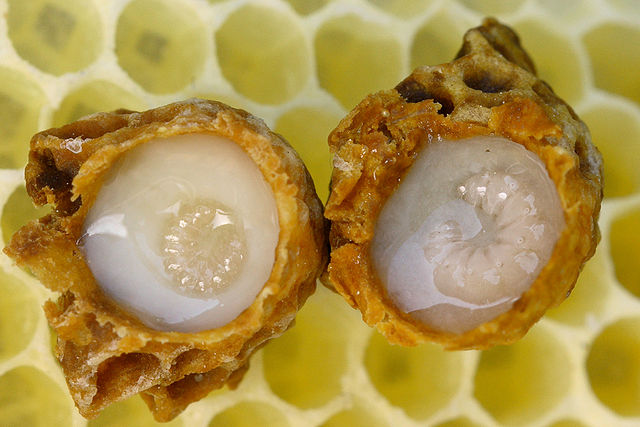Getting the buzz on the value of bees
Expert reviewers
Essentials
- Bees make more than honey. Around one third of what you eat is pollinated by bees
- The annual economic value of pollinators is worth between US $235 to $577 billion globally
- Bees are dying and their colonies are collapsing across the world, including in Europe and the United States
- Bees face a number of threats including parasites, pathogens, agricultural pesticides and malnutrition, poor beekeeping practices and climate change
- Scientists and beekeepers are worried that it won't be long until the Australian bee industry will be in real danger; with many already reporting increased difficulty in keeping their bees alive
Australian agriculture has been getting a free ride from honeybees for nearly 200 years. Their pollination services are worth several billion dollars a year, but Australia's honeybees are under increasing threat, from a range of different sources.
In many parts of the world the honeybee has been losing its buzz. Unusually high bee mortality has been reported across Western Europe. In the United States, the number of honey-producing colonies has declined from about 5.5 million in 1950 to less than 2.5 million in 2015, and there have been sudden colony losses in Japan, China and elsewhere. In some regions in China, bees have been lost entirely, and pollination has to be done by hand.
Australia’s honeybees have so far largely been luckier than their overseas counterparts. However, they still face a range of threats, including pollution, disease, pesticides, intensive agriculture, the introduction of alien species and climate change. As if this list isn't long enough, scientists and beekeepers are also worried that some of the destructive agents suspected of causing the world's big bee bust have already arrived on Australia's shores and may soon devastate the bee industry here. Initial signs of decline have already been seen, with outbreaks of diseases such as American Foulbrood, European Foulbrood and Nosema, as well as the spread of newly introduced parasites such as the small hive beetle.
The importance of bees
Worldwide there are more than 20,000 bee species, as well as a large number of subspecies and races, not all of which have been described by science. Despite this large number, only a fraction of these bees produce and store honey and build long-lasting nests (hives) made of wax. The well-known honeybees belong to the genus Apis and are known collectively as the Apini tribe.
Australia does not have any native Apis honeybees, but it does have over 1,600 species of other native bees. This diverse set of flying insects has evolved to exploit, and to work symbiotically with, the continent’s huge diversity of plant species, many of which are prolific producers of pollen and nectar. The bees that produce most of Australia’s honey are Western honeybees (Apis mellifera), also known as commercial or European honeybees. These were first brought to Australia in the 1800s to pollinate crops and to supply settlers with honey. Within a few decades these early bees had travelled across most of the country, making themselves at home both in the wild (where they are known as wild, or sometimes even feral) bees, and in artificial hives managed by beekeepers.
Honeybees may be most famous for the many different types honey—some which even have high antimicrobial properties—they serve up, but they do many other useful things as well. For example, they produce beeswax, which is used for the manufacture of candles and furniture polish and in food and skin-care products; propolis—a food product, thought to improve heart health and strengthen the immune system; and royal jelly—which has an anecdotal reputation as a health-food product. Bee poison has also been collected for a long time, and has been found to have anti-cancer effects.
Most importantly of all, bees play a major role in one of the most fundamental ecological processes—the pollination of plants.
Pollination is the process by which the male sex cells of a plant (the pollen) is transferred to the female sex organ (the ovule) of the same or another plant, resulting in fertilisation and hence sexual reproduction. It is an essential service—without pollination, life on the planet would be very different and probably much less diverse. The most common form of non-animal pollination is pollination by the wind (anemophily). However 90 per cent of pollination requires animals, and the animal most commonly involved is the honeybee.
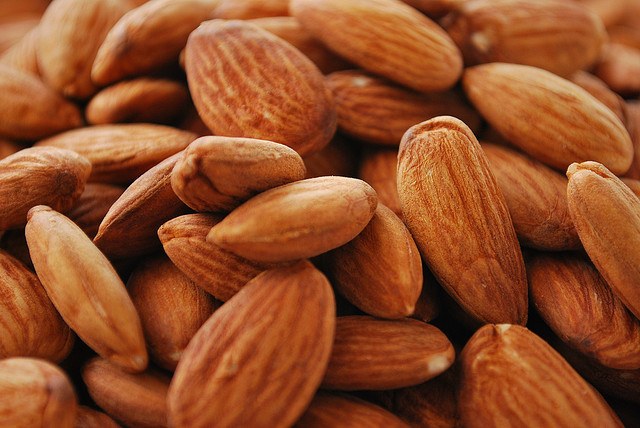
It is estimated that about one-third of global food production requires animal pollination and that 80–90 per cent of this role is carried out by honeybees, so these small insects are very valuable indeed. In Australia, two-thirds of all horticultural and agricultural crops need honeybees for optimal pollination. Many fruits, such as apples, raspberries and peaches, are more productive, produce better, more attractive fruit and even store better and for longer when they are serviced by honeybees. Lucerne, which is an important crop for feeding livestock such as cattle, is also much more productive when sufficient numbers of honeybees are available to promote pollination. Almond blossoms rely completely on honeybees for pollination—so, no bees, no almonds. It has been estimated that the value of honeybee-reliant agriculture in Australia is AUD $4–6 billion per year and rising.
| Plants, fruits and crops | Reliance on honeybees for pollination |
|---|---|
|
Avocado, almond, onion, sunflower |
100% |
|
Cucumber, mango, apple, asparagus, cherry, kiwifruit, rock melon, pumpkin |
90% |
|
Apricot, watermelon, other melon, plum |
70% |
|
Peach, nectarine |
60% |
|
Pear |
50% |
|
Orange, canola |
30% |
|
Cotton |
20% |
|
Grapes, tomato |
10% |
Australia’s honeybees are among the most disease-free in the world and are therefore in considerable international demand for their pollination services, especially in those countries that have suffered from sudden colony losses. For example, the value of Australian exports of honeybees to the United States in 2010, mainly for the Californian almond-flowering season, was around $7.5 million. The export of ‘controlled queen bees’—to reduce swarming and help maintain hive productivity—is also a valuable exercise. However, this industry is now mainly restricted to the export of Tasmanian bees since mainland exports have been halted due to the presence of the Asian honey bee and problems such as the small hive beetle.
Hard times ahead
Despite their many impressive skills and tight social cohesion, honeybees are under threat. In many parts of the world, entire colonies have been dying, a syndrome some have dubbed ‘Colony Collapse Disorder’ (CCD). The cause or causes of this phenomenon—where the majority of worker bees in a colony disappear, leaving behind plenty of food and a few nurse bees to care for the Queen and the remaining infant bees—are not fully understood. Initially scientists thought there may be one, single cause of CCD, but most now conclude that there is a long list of factors that can contribute to colony collapse.
For several years the term CCD gained traction in the media and was used to describe many instances of bee death and decline. However, CCD is still not fully defined, and there is now some agreement amongst scientists to move away from the term, because it basically refers to only a mass loss event.
Even without mass colony collapse, something is causing the honeybee to decline, so what is it? In 2016, the first global assessment of the state of the world's pollinators was released by an international team of 77 experts. They drew their results from the findings of approximately 3000 scientific papers, and also incorporated indigenous and local knowledge from over 60 locations around the globe. The report noted that the experts were concerned by declines, and cited numerous factors as being responsible. These include pollution, pesticide use, use of genetically modified crops, introduction of alien species, intensive agriculture, climate change, mass-breeding, transportation practices and the devotion of large areas of land to monocultures. As if this list wasn't long enough, honeybees are stalked by a range of mites, viruses and other diseases, and their vulnerability may be increased by over-work and poor bee-keeping practices.
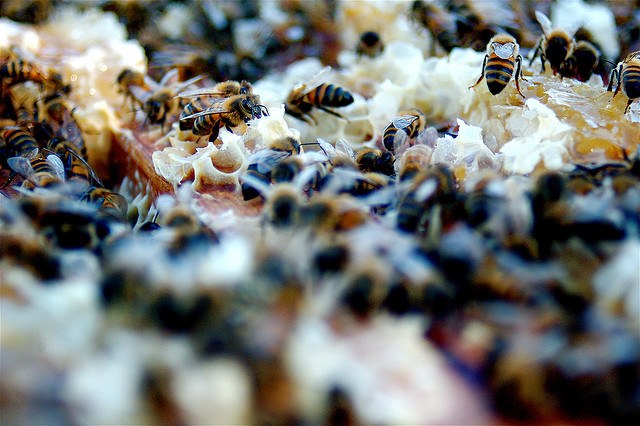
Honeybees are faring so badly in Europe that in 2013 the European Commission decided to ban the use of three neonicotinoid insecticides for a period of two years, in the hope that it would have a positive effect on bee populations. However, the decision has not been universally applied. Some member states of the EU (such as Finland, Romania, Germany, Latvia and Estonia) have provided farmers with exemptions from the law.
In the United States, an estimated 10 million beehives have suffered dramatic losses, worth around $2 billion dollars, in the last six years alone. A study conducted by scientists at the University of Maryland and the US Department of Agriculture identified a concoction of fungicides and pesticides that contaminate pollen, which bees collect and then feed to their hives.
Whilst Australia’s honeybees are currently faring better than their European and American counterparts, they are already afflicted by several imported maladies. Two bacterial diseases, American foulbrood and European foulbrood, are found in honeybee colonies in almost every Australian state (Western Australia is currently free of European foulbrood) and have the potential to cause significant numbers of deaths. Losses can be minimised, however, by good hive management and (in the case of European foulbrood) the use of low doses of antibiotics.
The Small hive beetle (Aethina tumida) is another major pest. It was first observed in Australia in 2002 and has spread widely in the east, especially in New South Wales and Queensland. A prolific breeder, the small hive beetle is now damaging honeybee colonies in several states. Management attempts have been made by using traps loaded with poison within hives, but on top of the concern about introducing poison into hives that produce a product for human consumption, beekeepers are reporting that the beetles are becoming increasingly tolerant to the poison. More research is needed to find sustainable long-term solutions.
While some bee-botherers are already in Australia, strict quarantine regulations and good luck have combined to exclude others. For example, several other species of honeybee, which would compete with the European honeybee for nesting sites and nectar and pollen resources, and could introduce new diseases, have not yet made it to Australian shores. These include the African honeybee (Apis mellifera scutelata), the giant honeybee (Apis dorsata), the Cape honeybee (Apis mellifera capensis) and bumble bees (Bombus species, which are already found in Tasmania).
On the other hand, the Asian honeybee (Apis cerana) has arrived in northern Queensland, to the dismay of Australian beekeepers, environmentalists and agriculturalists. It is of concern because it is known to rob European honeybee hives, is more aggressive, frequently swarms and may carry diseases to which Australian honey bees have no resistance.
The Varroa menace
There are numerous honeybee pathogens that can cause significant damage to bee populations, but perhaps the most dangerous of all the honeybee’s enemies is the aptly named 'destructor' mite—Varroa destructor—and its cousin, Varroa jacobsoni.
Both these mites were originally found on the Asian honeybee, but they have recently taken a liking to the Western (European) honeybee as well. On the Asian honeybee the mites only trouble drones, so their impact on a hive is relatively limited. But on the European honeybee both species are able to parasitise GLOSSARY drones and worker bees, greatly increasing the harm they can do to colonies. Our bees have no natural defence again these tiny threats, but honeybees from other parts of the world, such as Europe, have now been reported to have some resistance against the mite.
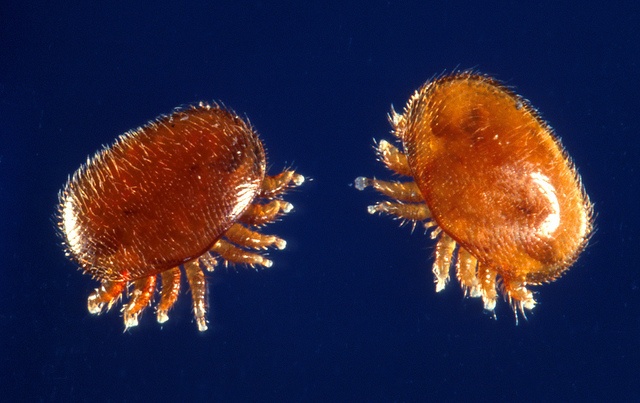
The Varroa mite attaches itself to the honeybee and feeds on its ‘blood’ (known as haemolymph); it can also infect the bee with bacteria and viruses, further weakening it and eventually causing its premature death. V. destructor is almost certainly a contributing factor to the losses bee populations have witnessed. Its introduction to Australia would likely cause a dramatic reduction in the country’s wild (feral) bee population and have major implications for the honey industry and agriculture.
At present Australia is the only country still free from Varroa. A number of efforts are being made to keep Australia Varroa-free and ward off the threat to Australian agriculture and the Australian beekeeping industry. The National Sentinel Hive Program, for example, was established in 2000 to help detect incursions into Australia by the Asian honeybee, the Varroa and Tropilaelaps mites, and other potential pests such as the African honeybee. It involves the placement and monitoring of empty hives at strategic locations, especially ‘high-risk’ sea ports where these pests are most likely to make landfall in Australia. This program is complemented by the Bee Force project, which is testing a volunteer-based, early-detection approach at the Port of Melbourne that, if successful, could be expanded nationwide.
Despite such initiatives, most experts agree that it is only a matter of time before new threats, such as the Varroa mite, arrives in Australia.
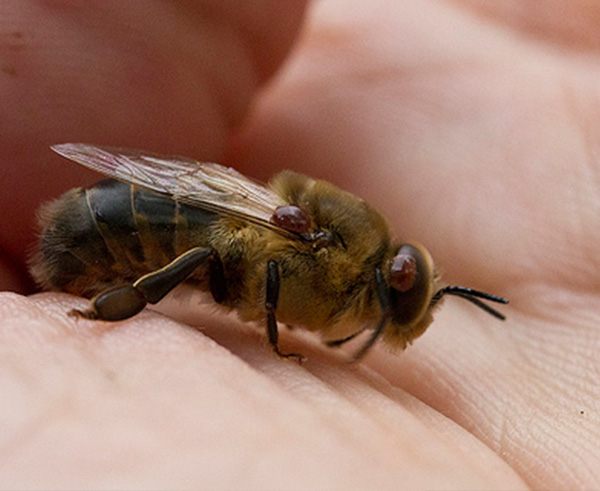
The impact of Varroa
Scientists predict the following outcomes once the V. destructor mite becomes established in Australia:
- The virtual disappearance of wild (feral) honeybees.
- A decrease in the number of managed honeybees, as colonies collapse due to infestation.
- An increase in the cost of beekeeping and therefore the cost of honey.
- The replacement of free pollination—currently performed by wild (feral) honeybees—by paid pollination.
- An increase in the cost of managed pollination, increasing the cost of agricultural production and therefore the price of food.
There seems little doubt that the eventual arrival of Varroa in Australia will change life for honeybees forever. It could mean the end of agriculture’s free lunch, as wild bees die off, and a very difficult and costly period for the beekeeping industry. Yet it will not spell the complete end of the European honeybee. In managed hives, it is possible to reduce the impact of Varroa through the use of insecticides and improved management techniques (although these will increase the costs of production and affect the quality of bee products). It may also be possible to increase the role of native bees in certain types of agricultural pollination and to breed European honeybees that are tolerant or partially resistant to infestation.
The key to avoiding disaster is to better understand the bee, its enemies and the ecology of pollination. Inevitably, science will play a crucial role in ensuring that the world’s greatest pollinator and its native cousins win their battle against destruction.
Other factors
Climate change may also be a factor in declining bee health. Both plants and pollinators display different responses to climate change, with small changes having the potential for serious consequences. For example, studies show that the Spider Orchid and the Miner bee depend on each other for reproduction. As temperatures have risen, the two have become 'out of sync', with the flower and the bee missing each other - and therefore the chance to pollinate. This is only one example of climate change disrupting the critical relationship between species.
Other causes such as lack of diversity or availability of pollen sources are also a factor. Dutch researchers analysed pollen found on the bodies of 57 different wild bee species collected prior to 1950. They were able to show that declines in plant biodiversity (through intensification of agriculture and climate change in the region) led to a decline of some of the domestic and wild bee populations.
Native bees
Australia’s highly diverse native bees range in size from a 2 millimetre midget (the Quasihesma bee) to what in comparison is a 24 millimetre flying bus (the great carpenter bee, Xylocopa). Most Australian native bees are solitary—a single female builds a nest and lays her eggs before dying in autumn, leaving behind larvae that develop over winter. Some are semi-social, however—several female bees cooperate to build a nest, in which they all lay eggs. There are also 14 species of ‘social’ native bee that form large colonies in similar ways to European honeybees and produce honey—including the famous bush tucker, ‘sugarbag’. These are known as ‘stingless’ bees because, unlike the honeybee, they do not possess a sting.
Some native bee species could become important pollinators of agricultural crops. For example, recent research at the University of Western Sydney and the University of Adelaide has shown the blue banded bee, a solitary bee of the genus Amegilla, to be more efficient than European honeybees at pollinating greenhouse-grown tomatoes. Blue banded bees ‘buzz’ pollinate—meaning that their wings vibrate at such a rate that they cause the flower’s pollen capsules to burst—a technique well-suited to tomatoes. Blue banded bees have been shown to cope well in a greenhouse environment and researchers are now developing a commercially viable breeding program for the species.
Another agricultural crop that has been shown to be pollinated effectively by native bees (in this case, the social Tetragonula species) is macadamia, itself an Australian native. An estimated 6 million macadamia trees in Australia produce around 35,000 tonnes of macadamia nuts per year.
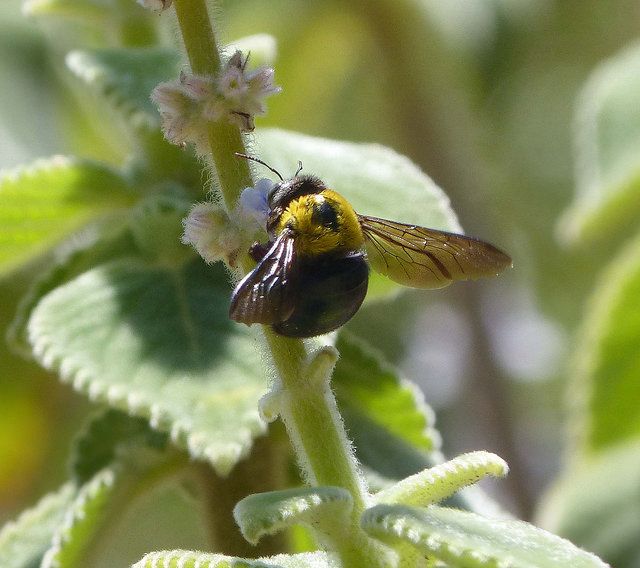
The future of Australia's honeybees
Ensuring sufficient pollinators
Farmers have a clear idea of most of the inputs they need to grow their products—such as water, fertilisers and pesticides—but many are less sure about the role of pollination in maximising yields. Not all crops require (or benefit from) honeybees for pollination, but the production of such crops as a percentage of total food production is increasing throughout the world. Pollination by honeybees increases the size, quality and/or stability of harvests for an estimated 70 per cent of the world's main crops. A review of long-term data by CSIRO scientist Saul Cunningham and others showed that an absence of honeybee pollinators would cause a reduction of global food production of up to 8 per cent, while the percentage increase in cultivated land needed to compensate for this shortfall would be several times greater, particularly in developing countries. Given its growing global population and a limit to agricultural expansion, the world can ill-afford a reduction in pollination services.
Since the 1800s, Australian farmers and horticulturalists have relied heavily on wild honeybees for pollination. Although there is uncertainty in the data it is likely that wild honeybees are responsible for about 70 per cent of Australian crop pollination. Given the likely invasion of the Varroa mite and other European honeybee pests, diseases and competitors, Australian farmers could be in the lull before the storm—it would be judicious to investigate other options should the wild honeybee population decline. Research is under way not only to help combat threats to the European honeybee but also to encourage other animals, including native bees, to play a greater role in agricultural pollination. For example, it has been demonstrated that pollination by native insects declines exponentially as the distance from natural habitat increases.
Whilst most native Australian bees are solitary rather than social and so cannot be kept in hives, and the few native species that are social are difficult to keep in large numbers, there are good reasons to promote the role of native bees in agricultural pollination. For example, native bees may be less susceptible than European honeybees to invasive pests. Two species of native stingless bee, Tetragonula carbonaria and Austroplebeia australis, have been shown to have excellent defences against the small hive beetle, which can have a devastating impact in the hives of the European honeybee. Both use a range of strategies against the beetle, including entombing it (and its eggs and larvae) in droplets of resin known as propolis.
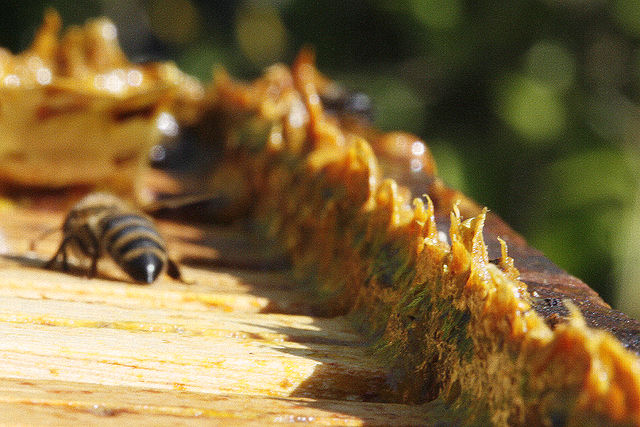
Protecting our bee populations
There is no doubt that Honeybees around the world have a tough road ahead. The threats they face are many and varied—parasites, pathogens, agricultural pesticides, malnutrition, poor beekeeping practices and climate change. Any one of these threats alone could cause distress and decline to bee populations, but when combined together, the cumulative effects can be severe.
With increased media attention and a dollar value placed on their pollination services over the last decade, governments and the wider public are now beginning to understand some of the issues affecting bees and why it is so important to restore bee health across the planet.
Researchers around Australia are working on ways to understand and combat the current and potential future threats to our honeybee populations. The Centre for Integrative Bee Research (CIBER) at the University of Western Australia is comprised of a team of multi-disciplinary scientists, using both field studies and laboratory experiments to study honeybee reproduction and immunity, along with honeybee DNA and proteins.
Other researchers at Macquarie University and the University of Sydney have teamed up to study how the stress of individual bees contributes to the health (or demise) of the entire colony, examining the process of bees' transitions from being hive bees to worker bees out in the broader environment.
CSIRO is also involved in bee research initiatives, leading the Global Initiative for Honeybee Health. This includes a project where 5000 bees have been fitted out with tiny sensors, then let loose into the enivironment. When the bees pass certain checkpoints, the sensors are detected, allowing the researchers to create a map of the bees' movements and better understand how they move through the landscape.
The issue is bigger than just having a jar of honey available in the pantry. Bees are an integral part of numerous eco-systems. If they disappear, not only do many of the foods we enjoy today go with them, but the flow-on effects of their removal from the environment could have longer, more serious consequences for plants, crops, other animals and ourselves.






